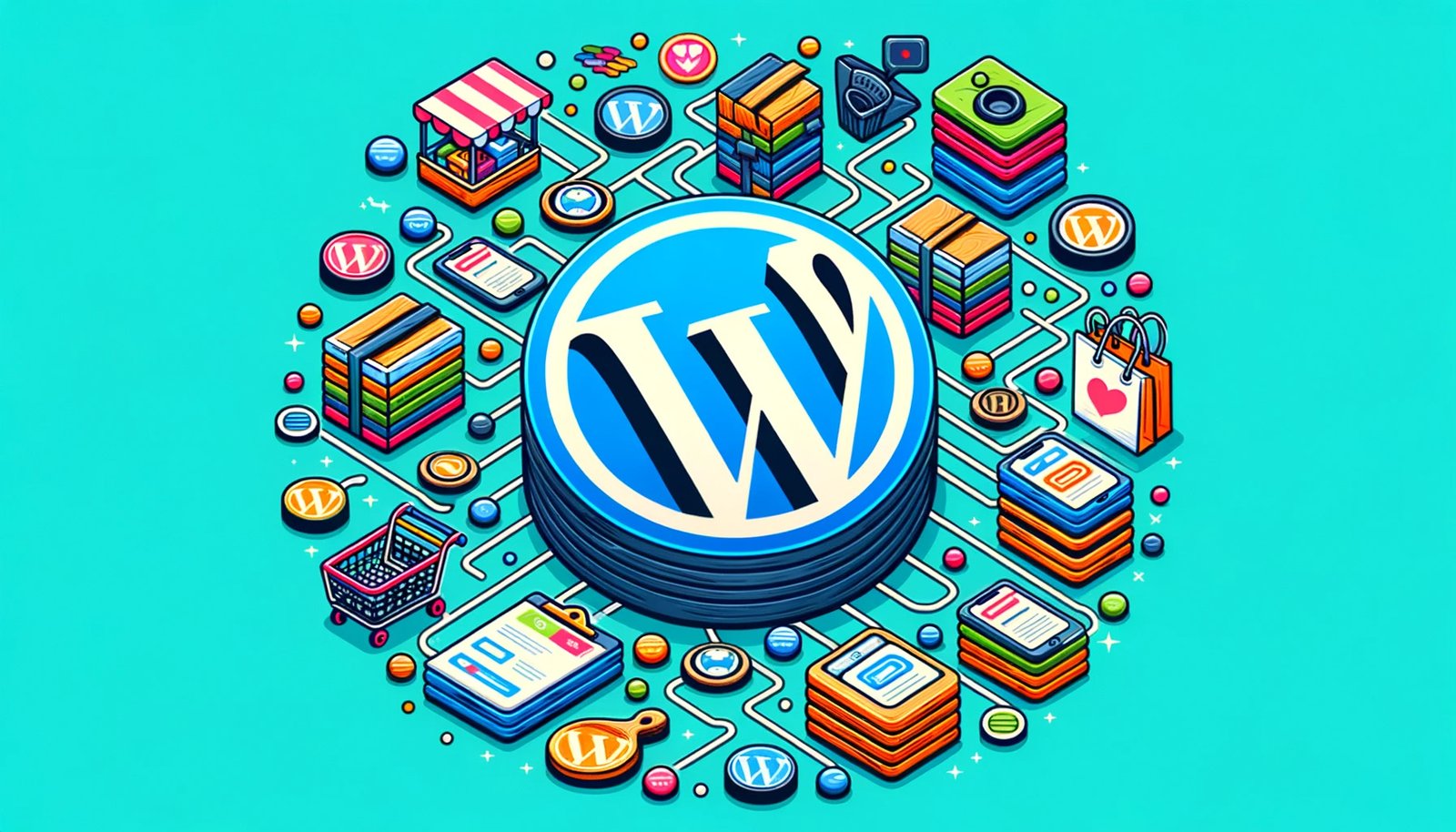Table of Contents
Toggle- Introduction – WordPress E-commerce Website Development
- Laying the Foundation: How to Create a WordPress E-commerce Website from Scratch
- Showcasing Your Storefront: How to Choose and Customize a WordPress E-commerce Theme
- Stocking the Shelves: How to Add Products to Your Website
- Streamlining Transactions: Setting Up Shipping and Payments
- Marketing Your Store: How to Promote Your WordPress E-commerce Website
- Attracting the Right Crowd: How to Optimize Your Website for Search Engines
- Guarding Your Assets: How to Improve the Security of Your E-commerce Website
- Keeping the Store Fresh: How to Maintain and Update Your Website
- Navigating the E-commerce World: Development Tips for Beginners and Small Businesses
- Enhancing the Shopping Experience: Best WordPress E-commerce Plugins and Themes
- Learning from Success Stories: WordPress E-commerce Website Case Studies
- Staying Ahead: WordPress E-commerce Website Trends for 2023
- Maximizing Conversions: How to Create a High-Converting E-commerce Website
- Driving Traffic and Sales: Strategies to Increase Traffic and Average Order Value
- The Impact of E-commerce Website Development on WordPress
- 1. The Advent of WooCommerce: A Game-Changer for WordPress
- 2. Enhanced Performance and Scalability
- 3. Rise of E-commerce-specific Themes and Plugins
- 4. Security Enhancements
- 5. Integration with Third-party Tools
- 6. Emphasis on Mobile Responsiveness
- 7. SEO and E-commerce
- 8. Globalization and Localization
- 9. Continuous Evolution and Community Support
- 10. The Future: Headless E-commerce
- Conclusion
WordPress E-commerce Website Development: Tips for Boosting Sales
Introduction – WordPress E-commerce Website Development
In today’s digital age, e-commerce has become a cornerstone of the global economy. With the rapid growth of online shopping, businesses are constantly seeking effective ways to tap into this lucrative market. One of the most popular and efficient platforms for this is WordPress. This article delves into the world of WordPress E-commerce Website Development, offering insights and tips to boost sales and enhance the online shopping experience.
The rise of e-commerce in the digital age
E-commerce has transformed the way we shop, conduct business, and interact with brands. The convenience of browsing products, comparing prices, and making purchases from the comfort of one’s home has made online shopping a preferred choice for many. With the global e-commerce market expected to reach trillions in the coming years, it’s evident that this trend is not just a passing phase but a significant shift in consumer behaviour.
Why WordPress is a top choice for e-commerce entrepreneurs
When it comes to establishing an online store, entrepreneurs have a plethora of platforms to choose from. However, WordPress stands out for several reasons. Firstly, its open-source nature means it’s highly customizable, allowing businesses to tailor their sites to their unique needs. Additionally, with a vast repository of plugins, including the renowned WooCommerce, WordPress E-commerce Website Development becomes a seamless process. The platform’s SEO-friendly structure, combined with its user-friendly interface, makes it a top choice for both beginners and seasoned e-commerce entrepreneurs.

Laying the Foundation: How to Create a WordPress E-commerce Website from Scratch
Embarking on the journey of creating an e-commerce website can be daunting. However, with the right approach and tools, it can be a rewarding endeavour.
Understanding the e-commerce ecosystem
Before diving into website development, it’s crucial to grasp the e-commerce ecosystem’s intricacies. This includes understanding customer behaviour, market trends, and the competitive landscape. By gaining insights into these areas, businesses can make informed decisions, ensuring their website aligns with their target audience’s needs and preferences.
Initial steps to setting up your online store
Setting up an online store on WordPress begins with choosing a reliable hosting provider. Once that’s in place, install WordPress and select a theme that resonates with your brand identity. With the foundation set, the next step involves installing essential plugins like WooCommerce, which will transform your site into a fully functional e-commerce platform. From here, configure the necessary settings, such as payment gateways, shipping options, and tax calculations, to ensure a smooth shopping experience for your customers.
Showcasing Your Storefront: How to Choose and Customize a WordPress E-commerce Theme
The design and layout of your online store play a pivotal role in attracting and retaining customers. A well-designed storefront can enhance user experience, boost conversions, and elevate your brand’s perception.
The importance of aesthetics and functionality in e-commerce
In the realm of e-commerce, first impressions matter. A visually appealing website can captivate visitors, encouraging them to explore further. However, aesthetics alone aren’t enough. The site must also be functional, ensuring that users can easily navigate, search for products, and complete their purchases without any hitches. Balancing beauty with functionality is the key to a successful WordPress E-commerce Website Development.
Tips for selecting a theme that resonates with your target audience
Choosing the right theme for your WordPress e-commerce site is crucial. Start by understanding your target audience’s preferences and behaviours. Opt for a responsive theme that looks great on both desktop and mobile devices. Ensure the theme supports essential e-commerce features and is compatible with plugins like WooCommerce. Lastly, prioritize themes that offer regular updates and robust customer support.
Stocking the Shelves: How to Add Products to Your Website
Once your storefront is set up, the next step is populating it with products. This involves more than just uploading images and setting prices; it’s about presenting your products in the best possible light.
Crafting compelling product descriptions and visuals
A product’s description and visuals are its primary ambassadors online. Craft descriptions that are clear, concise, and highlight the product’s benefits. Use high-quality images from multiple angles and, if possible, videos to give customers a comprehensive view of what they’re purchasing.
Organizing products for easy navigation
A well-organized product catalogue enhances user experience. Categorize products logically, use clear and descriptive labels, and offer filtering options. This ensures that customers can easily find and browse products, leading to increased sales.
Streamlining Transactions: Setting Up Shipping and Payments
The checkout process is where many e-commerce sites lose potential sales. Streamlining transactions can significantly reduce cart abandonment rates.
Choosing the right shipping options for your audience
Offer a variety of shipping options, from express deliveries to standard shipping. Consider offering free shipping for orders above a certain amount, as this can incentivize larger purchases.
Ensuring secure and diverse payment methods
Security is paramount in e-commerce. Ensure your site uses SSL encryption and is PCI compliant. Offer multiple payment options, from credit cards to digital wallets, catering to a broad spectrum of customer preferences.

Marketing Your Store: How to Promote Your WordPress E-commerce Website
Promoting your online store is as crucial as setting it up. With the right marketing strategies, you can drive traffic, increase brand awareness, and boost sales.
Leveraging social media, email marketing, and partnerships
Social media platforms like Facebook, Instagram, and Pinterest are goldmines for e-commerce businesses. Regularly post engaging content, run targeted ads, and collaborate with influencers to reach a wider audience. Email marketing, with its personalized touch, can help in retaining customers and informing them about new products or promotions. Additionally, forming partnerships with complementary businesses can open doors to their customer base, expanding your reach.
Crafting promotions and discounts to attract customers
Everyone loves a good deal! Offering timely discounts, flash sales, or loyalty programs can incentivize purchases. Ensure these promotions are prominently displayed on your WordPress E-commerce Website Development and shared across all marketing channels.
Attracting the Right Crowd: How to Optimize Your Website for Search Engines
Driving organic traffic to your website is cost-effective and can lead to higher conversions. SEO, or Search Engine Optimization, is the key to achieving this.
SEO strategies tailored for e-commerce
Optimizing product descriptions with relevant keywords, ensuring fast loading times, and having a mobile-responsive design is essential for e-commerce SEO. Regularly update your blog with informative content related to your niche, integrating keywords like WordPress web development for beginners or WordPress web development trends.
Importance of mobile optimization and site speed
With a significant portion of online shopping done via mobile devices, having a mobile-optimized site is no longer optional. Ensure your website loads quickly and offers a seamless shopping experience on all devices.
Guarding Your Assets: How to Improve the Security of Your E-commerce Website
In the digital realm, security is paramount. E-commerce sites, with their troves of customer data and transaction details, are prime targets for cyber-attacks.
Common e-commerce threats and countermeasures
From phishing attacks to DDoS assaults, e-commerce websites face a myriad of threats. Implementing firewalls, using secure payment gateways, and regularly monitoring for vulnerabilities are essential steps. Educate your team about the latest threats and ensure your WordPress E-commerce Website Development practices prioritize security.
Importance of SSL certificates and secure checkout processes
SSL certificates encrypt data between the user’s browser and the server, ensuring safe transactions. Websites with SSL also rank better on search engines. Moreover, a secure checkout process, with transparent payment gateways like Shopify E-commerce Website Development, instils confidence in customers, leading to increased sales.
Keeping the Store Fresh: How to Maintain and Update Your Website
A stagnant website can deter potential customers. Regular maintenance and updates ensure your site remains functional, secure, and in tune with the latest trends.
Regularly updating product listings and promotions.
Keep your product listings current. Remove out-of-stock items, add new products, and update product descriptions. Regular promotions, aligned with seasons or festivals, can attract more customers to your WordPress Blog Websites.
Ensuring the website runs smoothly with updates and backups
Update your WordPress platform, themes, and plugins regularly to benefit from the latest features and security patches. Regular backups ensure that, in the event of a mishap, your data remains safe and your website can be quickly restored.
Navigating the E-commerce World: Development Tips for Beginners and Small Businesses
E-commerce offers a world of opportunities, but it also comes with its set of challenges. For beginners and small businesses, navigating this landscape can be daunting.
Overcoming common challenges in the e-commerce domain
Inventory management, customer service, and digital marketing are common challenges. Leveraging tools, attending WordPress web development tutorials, and seeking mentorship can provide clarity and direction.
Strategies tailored for specific industries and platforms
Different industries have unique needs. A strategy that works for WordPress Real Estate Websites might not be suitable for WordPress Gym and Fitness Websites. Research, test, and iterate to find the best approach for your niche.
Enhancing the Shopping Experience: Best WordPress E-commerce Plugins and Themes
A memorable shopping experience can turn first-time visitors into loyal customers. Leveraging the right plugins and themes can significantly enhance this experience on your WordPress e-commerce site.
Plugins that enhance functionality and user experience
The right plugins can transform a basic website into a powerful e-commerce platform. Plugins like WooCommerce are essential for setting up an online store. Others, like Yoast SEO, can help optimize your site for search engines. For those looking to improve site speed, caching plugins can be invaluable. Always ensure that the plugins you choose, whether for WordPress web development for agencies or individual stores, are compatible with your theme and other plugins.
Themes that captivate and convert visitors
A theme dictates your website’s look and feel. For e-commerce, choose themes that are not only visually appealing but also optimized for conversions. Features like responsive design, easy navigation, and quick load times are essential. Platforms like Shopify E-commerce Website Development also offer a range of themes tailored for different industries.
Learning from Success Stories: WordPress E-commerce Website Case Studies
Analyzing successful e-commerce websites can provide valuable insights and inspiration for your venture.
Analyzing successful e-commerce websites and their strategies
From giants like Amazon to niche stores that have carved a name for themselves, there’s a lot to learn from successful e-commerce platforms. Study their website design, marketing strategies, customer service approaches, and more. Implementing proven strategies, whether for WordPress Tour and Travel Websites or other niches, can give you a competitive edge.
Key takeaways for aspiring e-commerce entrepreneurs
Success in e-commerce is often a blend of innovation, persistence, and continuous learning. Stay updated with the latest trends, be open to feedback, and always prioritize customer satisfaction.
Staying Ahead: WordPress E-commerce Website Trends for 2023
The digital landscape is ever-evolving. Staying updated with the latest trends ensures your e-commerce website remains relevant and competitive.
Predictions for the e-commerce world in the coming year
Voice shopping, augmented reality experiences, and AI-driven personalization are some of the trends expected to dominate in 2023. Integrating these into your WordPress E-commerce Website Development can set you apart from the competition.
Adapting to innovations and changing consumer behaviours
As technology advances, consumer behaviours and expectations shift. Regularly survey your customers, track analytics, and be ready to pivot your strategies based on emerging trends.
Maximizing Conversions: How to Create a High-Converting E-commerce Website
Conversions are the lifeblood of any e-commerce website. Ensuring that visitors not only browse but also make purchases is crucial for success.
Importance of user experience and trust signals
A seamless user experience can significantly boost conversions. Ensure your website is easy to navigate, loads quickly, and is mobile-responsive. Trust signals, like SSL certificates, customer reviews, and transparent return policies, can instil confidence in potential buyers, making them more likely to complete a purchase on your WordPress E-commerce Website Development.
Techniques to reduce cart abandonment and boost sales
Cart abandonment is a challenge many e-commerce sites face. Simplifying the checkout process, offering multiple payment options, and retargeting abandoned carts through email reminders or ads can help recover lost sales. Additionally, strategies like upselling and cross-selling can increase the average order value.

Driving Traffic and Sales: Strategies to Increase Traffic and Average Order Value
Driving traffic to your website is just half the battle; converting this traffic into sales is equally important.
Upselling, cross-selling, and bundling strategies
Upselling involves encouraging customers to purchase a higher-end product than the one they’re considering. Cross-selling recommends complementary products, while bundling offers a package deal at a discounted price. These strategies, when implemented effectively in WordPress web development for small businesses or larger enterprises, can boost sales and enhance customer satisfaction.
Engaging content marketing and loyalty programs
Content marketing, through blogs or videos, can drive organic traffic and position your brand as an industry authority. Loyalty programs, offering rewards or discounts to repeat customers can foster brand loyalty and encourage repeat purchases.
The Impact of E-commerce Website Development on WordPress
The digital age has transformed the way businesses operate, and e-commerce has emerged as a dominant force in the global marketplace. With the rise of e-commerce, the need for robust and scalable platforms to support online stores has become paramount. WordPress, initially known as a blogging platform, has evolved into a versatile content management system (CMS) capable of supporting e-commerce operations. This article delves into the profound impact of e-commerce website development on WordPress and how the platform has adapted to meet the demands of modern online businesses.
1. The Advent of WooCommerce: A Game-Changer for WordPress
WooCommerce, a free WordPress plugin, revolutionized the e-commerce landscape for WordPress users. Launched in 2011, it allowed users to transform their WordPress sites into fully functional online stores. Today, WooCommerce powers a significant portion of online stores worldwide, attesting to its popularity and effectiveness.
2. Enhanced Performance and Scalability
As e-commerce businesses grew, so did the need for high-performing websites that could handle increased traffic and transactions. WordPress developers recognized this need and introduced various optimizations and caching solutions to ensure that e-commerce sites run smoothly, even during peak traffic times.
3. Rise of E-commerce-specific Themes and Plugins
The e-commerce boom led to the development of numerous WordPress themes and plugins tailored for online stores. These themes are designed with e-commerce functionality in mind, offering features like product displays, shopping carts, and checkout processes. Plugins, on the other hand, extend the capabilities of e-commerce sites, offering solutions for payment gateways, inventory management, and more.
4. Security Enhancements
E-commerce sites handle sensitive customer data, including payment information. Recognizing the critical importance of security, WordPress has introduced numerous security measures, including regular updates, SSL integration, and specialized plugins to safeguard against potential threats.
5. Integration with Third-party Tools
To run a successful e-commerce business, integration with various third-party tools, such as payment gateways, CRM systems, and email marketing platforms, is essential. WordPress’s flexible architecture allows for seamless integration with these tools, ensuring a cohesive e-commerce ecosystem.
6. Emphasis on Mobile Responsiveness
With a significant portion of online shopping happening on mobile devices, e-commerce sites must be mobile-friendly. WordPress themes have evolved to be responsive, ensuring that online stores provide optimal user experiences across all device types.
7. SEO and E-commerce
Search engine optimization (SEO) is crucial for e-commerce sites to rank higher in search results and attract organic traffic. WordPress, known for its SEO-friendly nature, offers various plugins like Yoast SEO to help e-commerce businesses optimize their content and improve their search rankings.
8. Globalization and Localization
E-commerce businesses often cater to a global audience. WordPress supports multilingual plugins, allowing e-commerce sites to offer content in multiple languages. Additionally, plugins like WooCommerce offer localization features, enabling businesses to cater to local markets effectively.
9. Continuous Evolution and Community Support
The WordPress community plays a pivotal role in the platform’s evolution. As e-commerce trends change, the community actively develops new plugins, themes, and solutions to address emerging challenges and opportunities.
10. The Future: Headless E-commerce
The concept of headless e-commerce, where the front end and back end of a website operate independently, is gaining traction. WordPress is at the forefront of this trend, with solutions that allow businesses to leverage the platform’s backend capabilities while using a different technology for the frontend.
Conclusion
Building a successful e-commerce website is a journey filled with challenges and opportunities. By leveraging the power of WordPress, prioritizing user experience, and staying updated with the latest trends, businesses can create a thriving online store. As we reflect on the transformative journey of building an e-commerce website, we encourage readers to embark on their e-commerce adventure with WordPress.
-
- Why choose WordPress for e-commerce website development?
- Discussing the platform’s adaptability, extensive plugin ecosystem, and user-friendly interface tailored for e-commerce.
- Which WordPress plugins are essential for an e-commerce website?
- Highlighting popular plugins like WooCommerce, Easy Digital Downloads, and WP eCommerce and their unique features.
- How can I optimize my WordPress e-commerce site for faster loading times?
- Tips on image optimization, caching solutions, and minimizing scripts for better site performance.
- What strategies can I implement to enhance the user experience on my e-commerce site?
- Discussing the importance of intuitive navigation, mobile responsiveness, and clear call-to-action buttons.
- How can I effectively showcase my products to boost sales?
- Suggestions on using high-quality images, product videos, and detailed descriptions to engage potential buyers.
- What are the best practices for setting up secure payment gateways on my WordPress e-commerce site?
- Emphasizing the importance of SSL certificates, choosing reputable payment gateways, and ensuring data protection.
- How can I use email marketing to retain customers and promote repeat purchases?
- Introduction to plugins that integrate email marketing and tips on creating effective email campaigns.
- What strategies can I use to build trust and credibility on my e-commerce website?
- Discussing the significance of customer reviews, trust badges, and transparent return policies.
- How can I optimize my e-commerce website for search engines to drive organic traffic?
- Tips on SEO best practices specific to e-commerce, such as optimizing product descriptions and using schema markup.
- What techniques can I implement to reduce cart abandonment rates on my e-commerce site?
- Suggestions on offering guest checkouts, sending cart abandonment emails, and ensuring a smooth checkout process.







